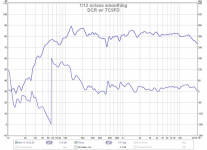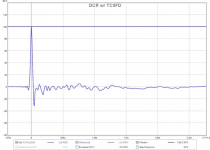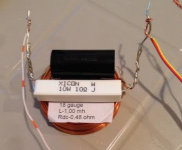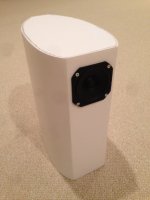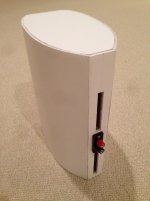Hello,
congrats! Nice job 🙂
If you feel inclined: try eqing the BSC only to ~6khz. Above that a slight rise can be helpful with the highfreq. energy "dispersion" of a fullranger. It helps with the impression of airy and "fine" HF.
Regards
congrats! Nice job 🙂
If you feel inclined: try eqing the BSC only to ~6khz. Above that a slight rise can be helpful with the highfreq. energy "dispersion" of a fullranger. It helps with the impression of airy and "fine" HF.
Regards
Sayrum,
Thanks for the tip. I will try that. That is one of the reasons I wanted to add a capacitor in parallel with the BSC was to bring up the HF. Maybe try a bigger cap to get the high pass closer to 6khz. I can certainly try this in DSP tonight to hear the difference right away. To my ears, the Vifa when EQ'd flat appears to have pretty good HF - but never specifically tried to let it rise from 6khz on up.
X
Thanks for the tip. I will try that. That is one of the reasons I wanted to add a capacitor in parallel with the BSC was to bring up the HF. Maybe try a bigger cap to get the high pass closer to 6khz. I can certainly try this in DSP tonight to hear the difference right away. To my ears, the Vifa when EQ'd flat appears to have pretty good HF - but never specifically tried to let it rise from 6khz on up.
X
The problem with the Yohng wrapper is that it is not very stable. I have tried it with some different plug-ins and always have found the results not worth the bother. I don't use many plug-ins. At the moment, all I have is an SRC, the graphic EQ and the advanced limiter. Even the SRC may go. My next quest will be to see if there is any difference between coming out of the computer USB or HDMI. Always something else to try.
Bob
The Yohng wrapper seemed perfectly stable with foobar 1.3.1 and the EasyQ plugin on my system here. There is always this VST wrapper as an alternative Foobar2000:Components/VST adapter - Hydrogenaudio Knowledgebase
What is SRC plugin? Now that you point out some potential instabilities that may plague shareware - it may make sense to buy Jriver for $50. It is a pretty slick package that comes with most of the popular plugins already preloaded. I am still using the soundcard built into the desktop PC motherboard - which seems to sound pretty good. I bet switching to an external DAC might just blow me away. I only have USB and 1394 interface on this 8 yr old PC though. Even my newer laptop has HDMI. MiniDSP has an HDMI input DSP now.
SRC is the Secret Rabbit Code Resampler, a resampling plugin for Foobar. I use the alternative SOX resampler http://www.hydrogenaudio.org/forums/index.php?showtopic=67373 in my foobar setup.
Hey
the 6khz are a starting point. As see in your graph the drive has a natural rise starting around that freq. Just let it do its thing...
i would try 6khz and higher, as the human ear seems to be extra sensitive around 3 - 5 khz, so a little less energy in that area can often sound better (less stressing for longer listening).
the 6khz are a starting point. As see in your graph the drive has a natural rise starting around that freq. Just let it do its thing...
i would try 6khz and higher, as the human ear seems to be extra sensitive around 3 - 5 khz, so a little less energy in that area can often sound better (less stressing for longer listening).
Here is response close to a wall and at 0.5m away and lower drive voltage:
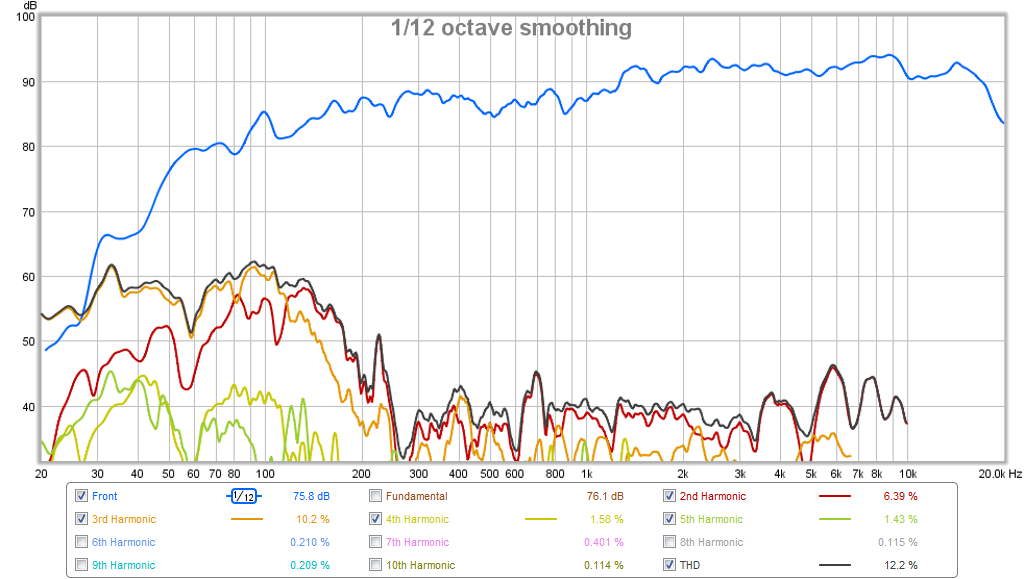
SRC is the Secret Rabbit Code Resampler, a resampling plugin for Foobar. I use the alternative SOX resampler A new resampler DSP for foobar2000 - Hydrogenaudio Forums in my foobar setup.
Close. Secret Rabbit Code is one version of a Sample Rate Converter. If you run your player with no DSP or volume control, The player will output the same bit depth and rate as the music file. An SCR will convert to another depth/rate if you need to. If you do use DSP or volume control, the music is converted to floating point, processed and passed to the SCR for conversion back to PCM. I my case, the nanoDIGI will takes 24/96, so that's what I want out. I could use any of the SCR's inside or plugged into FB2K or let the win8 DS do it. I have yet to decide if there is any SQ difference between the various SCR's.
Bob
Hello,
congrats! Nice job 🙂
If you feel inclined: try eqing the BSC only to ~6khz. Above that a slight rise can be helpful with the highfreq. energy "dispersion" of a fullranger. It helps with the impression of airy and "fine" HF.
Regards
Sayrum,
I tried your suggestion of "letting the driver do its thing" above 6kHz and it does indeed sound better - more top end airiness without any fatigue. You only notice it on tracks that have content up there. Many tracks sound good as usual with no apparent boost in HF. So I think in general it is quite neutral. I implemented it by applying a high shelf at 6khz to put the same amount of boost (9dB) that I took off from the BSC shelf which started at 750Hz. Of course doing this in DSP was trivial and maybe in hardware BSC circuit I just need the equivalent capacitor that emulates a 6kHz high pass strapped in parallel with the coil and resistor. Anyhow, thanks for the tip. We are both TC9FD aficionados and I think this helped me to get a little more air out of them.
Uniformity of polar response for TC9FD
I was looking at the polar response data of the Vifa from the Nautaloss and wonder how the DCR with curved baffle edges will compare. I hope maybe even better? It may be primarily dominated by the shape of the cone and dust cap though. I have a theory why it works so well: the dust cap acts like a 3/4 inch dome tweeter and the smoothly curved exponential looking cone looks like a nice waveguide that you see on some high end dome tweeters. If there wasn't the bump created by the half roll rubber surround, it would probably be even better. I think that a full range driver with a smaller round dust cap and smooth curved cone vs a flat or non curved conical cone will have better HF uniformity and polar response than one with non round dust caps, phase plugs, whizzers, heatsink phase plug, etc. You want the driver to look like a dome tweeter in a waveguide.
Here is the data from the Nautaloss I:
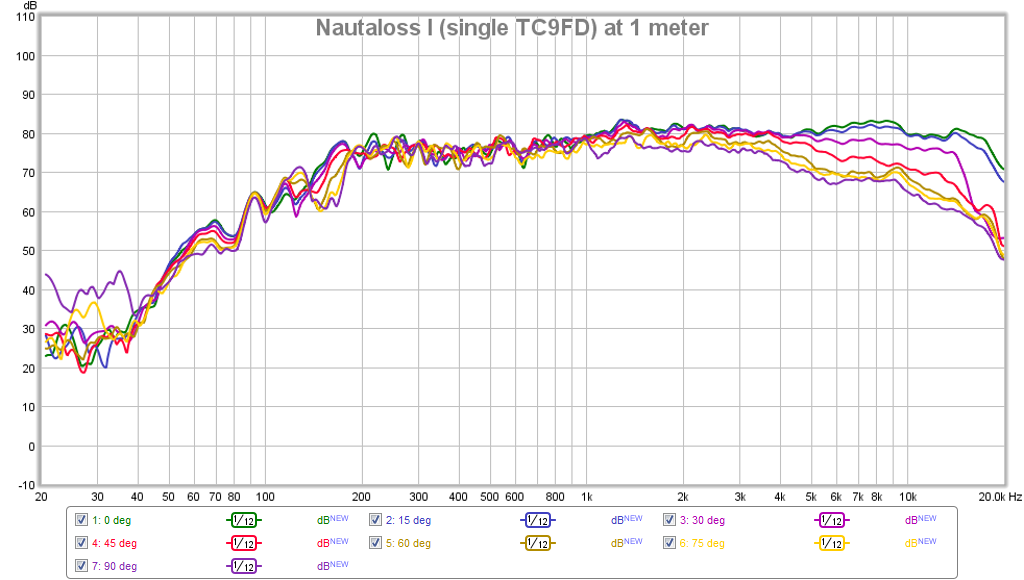
I was looking at the polar response data of the Vifa from the Nautaloss and wonder how the DCR with curved baffle edges will compare. I hope maybe even better? It may be primarily dominated by the shape of the cone and dust cap though. I have a theory why it works so well: the dust cap acts like a 3/4 inch dome tweeter and the smoothly curved exponential looking cone looks like a nice waveguide that you see on some high end dome tweeters. If there wasn't the bump created by the half roll rubber surround, it would probably be even better. I think that a full range driver with a smaller round dust cap and smooth curved cone vs a flat or non curved conical cone will have better HF uniformity and polar response than one with non round dust caps, phase plugs, whizzers, heatsink phase plug, etc. You want the driver to look like a dome tweeter in a waveguide.
Here is the data from the Nautaloss I:

Last edited:
Measurements with Speaker-Level BSC
The BSC parts (Jantzen 1.0 mH air core inductor, 10 ohm 10 watt resistor, Dayton 0.47 uF 400 V audio grade poly cap) arrived and I wired it up, soldered the leads and connected it to the DCR speaker externally to test in the listening position as a computer monitor. I turned off all the DSP BSC, but left the left+right mixing to mono. Listening to it, it sounds very good - the bass actually sounded more natural and full; the mids and highs were just right without any hint of fatigue or harshness. Based on my listening impressions, I expected the measurements to show good balance similar to the simulations which was used to set the BSC component values.
I decided to measure it in place - where I would be using it rather than move it to the middle of the room on a stand. So there is a computer, a wall, and the desk all nearby to contribute to reflections, etc.
Here are the measurements of the DCR speaker with the hardware-based BSC installed, with the mic about 0.5m away from the driver at listening position.
Frequency response and acoustic phase - the BSC did its job perfectly and the phase is still fairly linear over the 500 Hz to 20 kHz range, and there is no phase wrap at 500 Hz this time with the hardware-based BSC:
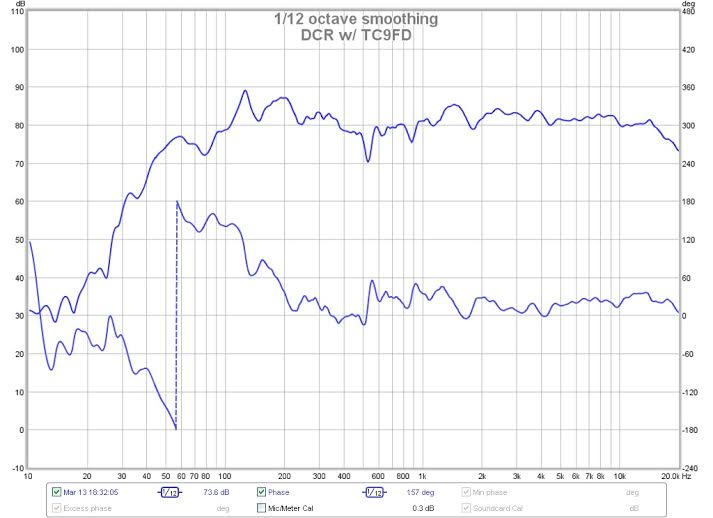
The harmonic distortion also looks very good - now it is circa -30dB in the sub 100 Hz region, and varies from -45dB to -55dB from 300 Hz on up:
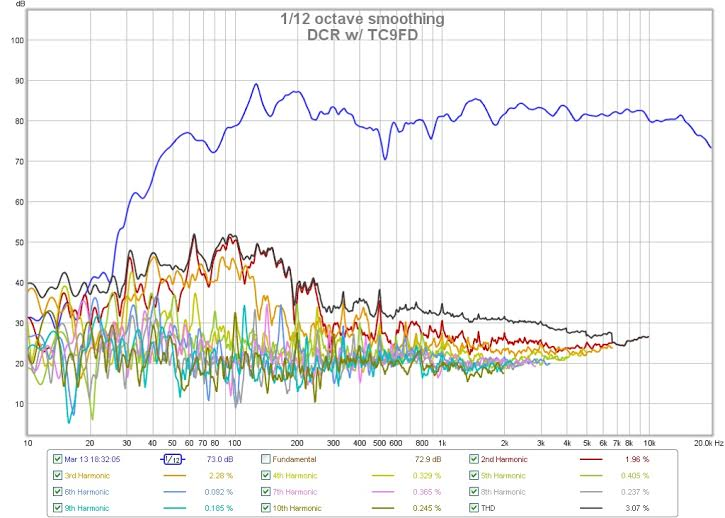
Here is the Impulse Response - which really cannot get much better:
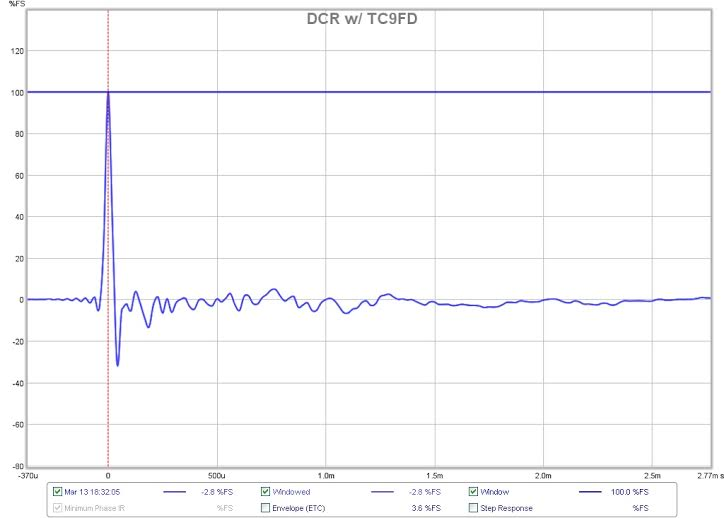
I haven't had much time to listen to more than 3 or 4 tracks, but so far the sound quality has exceeded my expectations for a simple fullrange computer speaker. The clarity of the mids and highs is excellent, and the bass is actually quite satisfying and substantial. I don't think a sub-woofer is necessary for most music. The dips and peaks from measuring the speaker in the actual real-world listening position of the computer desk doesn't seem to be noticeable in listening to music. It sounds excellent and I am very happy with the outcome. I highly recommend this build. The BSC components, although the cost as much as the drivers - are needed if you do not intend to use DSP, and make the sound very even and pleasing to the ear.
The BSC parts (Jantzen 1.0 mH air core inductor, 10 ohm 10 watt resistor, Dayton 0.47 uF 400 V audio grade poly cap) arrived and I wired it up, soldered the leads and connected it to the DCR speaker externally to test in the listening position as a computer monitor. I turned off all the DSP BSC, but left the left+right mixing to mono. Listening to it, it sounds very good - the bass actually sounded more natural and full; the mids and highs were just right without any hint of fatigue or harshness. Based on my listening impressions, I expected the measurements to show good balance similar to the simulations which was used to set the BSC component values.
I decided to measure it in place - where I would be using it rather than move it to the middle of the room on a stand. So there is a computer, a wall, and the desk all nearby to contribute to reflections, etc.
Here are the measurements of the DCR speaker with the hardware-based BSC installed, with the mic about 0.5m away from the driver at listening position.
Frequency response and acoustic phase - the BSC did its job perfectly and the phase is still fairly linear over the 500 Hz to 20 kHz range, and there is no phase wrap at 500 Hz this time with the hardware-based BSC:

The harmonic distortion also looks very good - now it is circa -30dB in the sub 100 Hz region, and varies from -45dB to -55dB from 300 Hz on up:

Here is the Impulse Response - which really cannot get much better:

I haven't had much time to listen to more than 3 or 4 tracks, but so far the sound quality has exceeded my expectations for a simple fullrange computer speaker. The clarity of the mids and highs is excellent, and the bass is actually quite satisfying and substantial. I don't think a sub-woofer is necessary for most music. The dips and peaks from measuring the speaker in the actual real-world listening position of the computer desk doesn't seem to be noticeable in listening to music. It sounds excellent and I am very happy with the outcome. I highly recommend this build. The BSC components, although the cost as much as the drivers - are needed if you do not intend to use DSP, and make the sound very even and pleasing to the ear.
Attachments
Last edited:
In the pages 67 & 69 of "TABAQ" thread you can find my measurements of TG9FD.Wonder how this driver would perform in a identical internal "proper" cabinet....😎
Last edited:
In the pages 67 & 69 of "TABAQ" thread you can find my measurements of TG9FD.
Erkki - indeed, but in this regard I meant "proper" as in a curvy DCR cabinet out of wood/MDF/heavy materialt identical to xrk's foam version 🙂 Cabinet do matter, not only to the eye 🙂
More meas with BSC and improved position
I moved the speaker around on my desk to get the rear ports 3 in from wall and removed desktop "floor" bounce cancellation dip. Here is the new measurement at a realistic listening SPL of about 75dB. The SPL variation or flatness is quite good with +/- 3dB over 52 Hz t0 20 kHz. Note that the HD is now around -30 to -35dB in the 50 Hz to 100 Hz range which shows how well a dual chamber reflex can work in providing rather satisfying bass with lower distortion. There is some distortion in the 100 Hz to 200 Hz range that takes it to -27dB but mostly it is 2nd harmonic which really is not that objectionable. In general, the sounds is very nice and pleasing to the ear.
SPL and HD vs Freq:
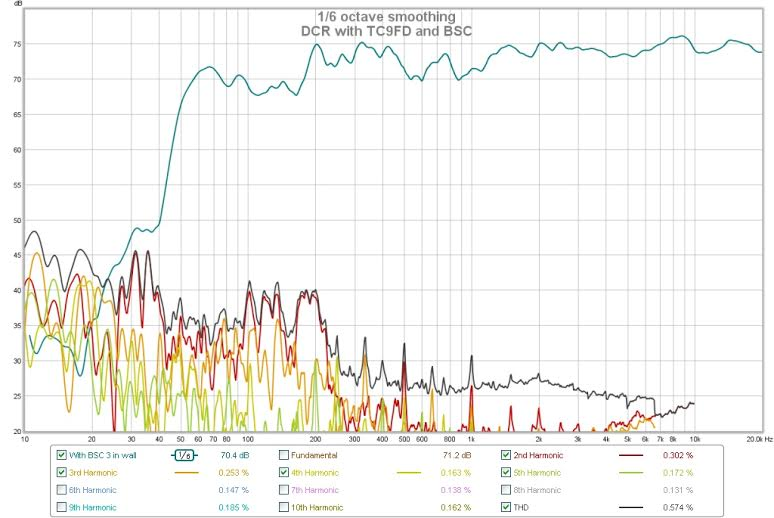
Here is a photo of the BSC circuit:
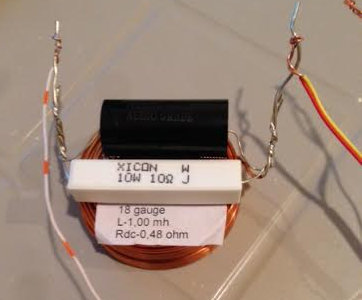
I moved the speaker around on my desk to get the rear ports 3 in from wall and removed desktop "floor" bounce cancellation dip. Here is the new measurement at a realistic listening SPL of about 75dB. The SPL variation or flatness is quite good with +/- 3dB over 52 Hz t0 20 kHz. Note that the HD is now around -30 to -35dB in the 50 Hz to 100 Hz range which shows how well a dual chamber reflex can work in providing rather satisfying bass with lower distortion. There is some distortion in the 100 Hz to 200 Hz range that takes it to -27dB but mostly it is 2nd harmonic which really is not that objectionable. In general, the sounds is very nice and pleasing to the ear.
SPL and HD vs Freq:

Here is a photo of the BSC circuit:

Attachments
Last edited:
Quite an achievement, xrk. This is a very refined FC speaker. 😀
Sent from my GT-I8190 using Tapatalk
Sent from my GT-I8190 using Tapatalk
Erkki - indeed, but in this regard I meant "proper" as in a curvy DCR cabinet out of wood/MDF/heavy materialt identical to xrk's foam version 🙂 Cabinet do matter, not only to the eye 🙂
I have seen curvy cabinet out of routed plywood only in Wesayso's towers and the Magico Mini. Both are sealed designs though. A stiff or rigid enclosure will accentuate peaks more with high Qts driver and require more damping internally. I think that the foam core walls flex and absorb the peaks and provide a smoother sounding enclosure. There is a small amount of secondary acoustic emission from the cabinet but that is well below (probably -30 or -40dB) the main port and direct radiator emission.
Quite an achievement, xrk. This is a very refined FC speaker. 😀
Sent from my GT-I8190 using Tapatalk
Thanks VonAh! Did I mention that I am powering it from the stock Sure TPA3110D2 ? Nice amp for $10.
Sweet. I have been thinking of those and the Vifas to populate my sister's new house with distributed sound. Since I am the audio nerd of the family, I have been asked to come up with music distribution solutions. 😀
[/OTdiscussion]
Sent from my cheapo phone via Tapatalk
[/OTdiscussion]
Sent from my cheapo phone via Tapatalk
VonAh,
Are you talking about distributed sound as in wall speakers or as small units all over the house? This DCR may be a good candidate as it is fairly compact and sounds great. You can put a witless receiver for distributed sound and a tpa3110 inside each and put them wherever you want.
Are you talking about distributed sound as in wall speakers or as small units all over the house? This DCR may be a good candidate as it is fairly compact and sounds great. You can put a witless receiver for distributed sound and a tpa3110 inside each and put them wherever you want.
Small units throughout the house was my idea (and probably hers). Various FC builds may suit, too. Easy testing! The wall mounted TL and Cornu's would probably be well received, but small cabinets would probably work, too. Which wireless transmitters/recievers will be interesting to decide (and if they can sync). I still need to have an in-depth chat with her about what she (and my brother-in-law) would want/accept. 😀
Speaker Completed with BSC & Binding Posts
The speaker sounds great now and I am happy enough to install the BSC circuit permanently inside (hot melt glued to divider plate through the cutout). I also installed some real binding posts on the back. The surprise was the improvement in the sound when I hooked it up through properly soldered connections and a binding post rather that hand-twisted temporary wire leads during testing. It sounds more clear and the bass seems to have more impact. Loose connections can rob clarity and bass is what I just experienced.
Here are some sound clips of how it sounds at my desk (still in mono). Let me know what you think.
The speaker sounds great now and I am happy enough to install the BSC circuit permanently inside (hot melt glued to divider plate through the cutout). I also installed some real binding posts on the back. The surprise was the improvement in the sound when I hooked it up through properly soldered connections and a binding post rather that hand-twisted temporary wire leads during testing. It sounds more clear and the bass seems to have more impact. Loose connections can rob clarity and bass is what I just experienced.
Here are some sound clips of how it sounds at my desk (still in mono). Let me know what you think.
Attachments
Last edited:
- Home
- Loudspeakers
- Full Range
- Viva la Vifa! Curvy Cabinet DCR with TC9FD
